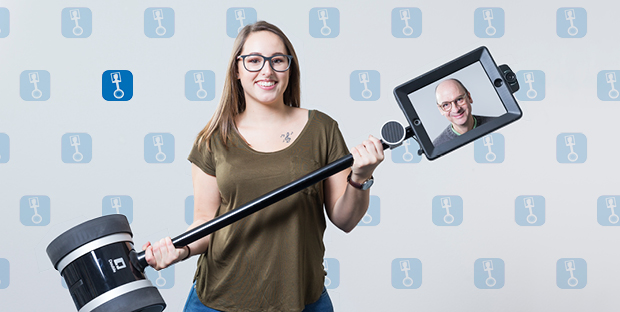Video Conferencing: Presence, Telepresence and Telepresence Robots
Video conferences have long since progressed from fixed spaces to one’s own workstation and mobile devices. That’s why new devices are aiming to score points with different characteristics: these combine camera and screen in a tablet, sometimes even placed on a movable stand, and therefore enable mobility and allow the user to control them remotely. This means that not only can their position be changed within the conference room, but the perception and representation of absent persons can also be actively influenced.
Thus, by means of mobile devices, they open up the possibility of active utilization of remote rooms: in bigger offices, users can steer towards different locations in order to make observations or to initiate communication processes, both formally and informally. Thus remote employees have greater scope for participation in communication processes on site.
Video Conference + Robots = Telepresence Robots
With the smaller, location-specific solutions, the advantage of mobility and remote controlling lies in improved perception: In the context of a meeting, the remote person can turn to face different objects or people in a conversation and thus direct their own attention for themselves.
In addition – and this is the difference in relation to conventional video conferences, where presence is limited to a stationary screen – these activities carried out by the absent person become visible at the location. This applies not only to a video conference device rolling into the office, but also the combination of camera and screen, including for smaller devices: now, those discussion partners who are present can recognise a change in the focus of the remote person’s attention, since this not only moves the camera, but at the same time changes their own representation in the meeting room, e.g. because the tablet turns, something a fixed monitor does not permit.
In combination, the devices should boost a person’s perceived presence, or «telepresence». This is an essential prerequisite, primarily of informal communication, and even today remains a shortcoming of remote collaboration or telework.
Whether the new devices can make a contribution towards reducing this deficit is part of the tests that IT Services’ Multimedia Services are currently carrying out. Interested parties are warmly invited to take a look at the devices we have, try them out or even borrow them.
Links to further information
- Double https://www.doublerobotics.com/
- Kubi https://www.revolverobotics.com/
- Video conference service ITS MMS (ITS Web)
Contact
- IT Services, ITS Multimedia Services (ITS MMS)
- Armin Brunner, Head of Multimedia Services (ITS MMS)
- Christopher Sauder, Videoconferencing & Collaboration (ITS MMS)

erstellt am
in News


